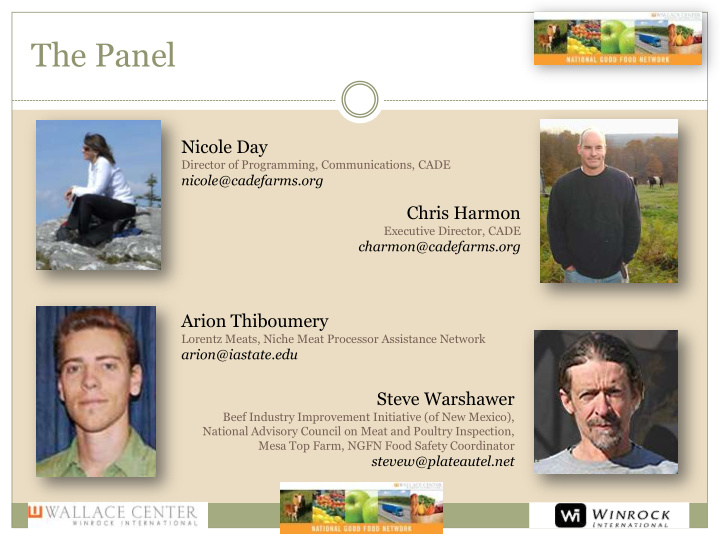



The Panel Nicole Day Director of Programming, Communications, CADE nicole@cadefarms.org Chris Harmon Executive Director, CADE charmon@cadefarms.org Arion Thiboumery Lorentz Meats, Niche Meat Processor Assistance Network arion@iastate.edu Steve Warshawer Beef Industry Improvement Initiative (of New Mexico), National Advisory Council on Meat and Poultry Inspection, Mesa Top Farm, NGFN Food Safety Coordinator stevew@plateautel.net
I Need More Meat Processing Capacity - Where Do I Start? Work with them! Book slaughter early and book often. Is a good local processor available? Work with other producers to ship animals collectively to a distant processor that you like. Book early and book often. No – None Available When volumes exceed 400 head of beef (or 1200 hogs or 2000 lambs or goats) per year , start to consider Talk with processor, be polite and constructive. • building your own plant Work with them on their constraints • Ask how you can participate in solutions • Chart by Arion Respect the challenges of change, especially Thiboumery, NMPAN & since you are only one of many customers Lorentz Meats
Mobile Slaughter/Processing Units These are not Mobile Processing Units (MPU), but rather these are Mobile Slaughter Units (MSU’s). Every MPU we have looked at, including the Island Grown Farmer Cooperative (IGFC) in San Juan County, WA and the LILA MPU is actually a MSU. After the animals are killed, gutted and skinned they are shipped to a USDA Processing facility for breakdown of the carcass. All MPU’s, or MSU’s require the bricks and mortar of a USDA processor . Especially for hanging and aging carcasses. In some cases carcasses could be cut into primals and cryovacked in an MPU, or even broken down into subprimals, but you still need to age the beef, even for seven to ten days. MPU’s have a hotbox to cool down the hot carcass after slaughter, but the cost of hanging a carcass for aging in this would be expensive . The Glynwood Center’s system has a refrigerated truck to haul carcasses to a USDA processor, but again, the cost of aging a carcass in this would also be expensive.
Pros of Mobile Slaughterhouse Units In some areas, like Lopez Island, or the affluent Hudson Valley, developing complete slaughterhouses is prohibitive. Either there aren’t enough animals, or there is a NIMBY attitude. In these cases, MSU’s may be the only option available. For areas with many 20-C licensed facilities MSU’s are very useful. A 20-C license allows the license holder, often restaurants, grocery stores, and farms, to further process, or fabricate, stamped carcasses, halves, quarters and boxed meats. In many cases these 20-C licensed facilities have the capacity to age a few carcasses. MSU’s work very well with smaller animals like hogs, lambs and sheep, goats, and smaller cattle.
Cons of Mobile Slaughterhouse Units (MSU’s) Through put! The real issue for slaughterhouses is how many animals can you put through the facility in a given day. MSU’s are limited in the amount of through put the unit can do in a given day. They are fairly expensive . Not only are you purchasing the MSU, but in some cases there is also a trailer for the USDA office and the showers and break room. There is the refrigerated truck that transports the carcasses to the processing facility, and there is an offal truck to remove the animals innards. In some cases, as on Lopez Island, the offal can be composted on the farm they are visiting. Depending upon the model they also require a concrete or asphalt pad to set up to be level as well as electric, water and tanks for waste water. The cost of developing one of these pads can run $35,000 -$45,000 . They are not necessarily mobile ! Except for the IGFC model, most of these do not travel from farm to farm where the animal is slaughtered on the farm. (Note: in the case of poultry mobile units they are mobile slaughter and mobile processors. The unit does travel to the farm and the killing and processing are done on the farm. In the case we are familiar with the animals are hauled to a “docking station” where the MSU has been set up. There the animals are aggregated, killed, and the carcasses are hauled to a processing plant.
Recommend
More recommend